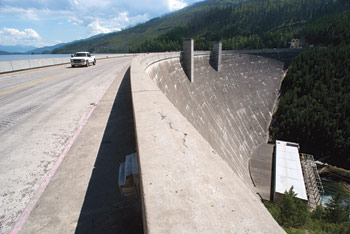During their visit from Idaho to Northwest Montana last week, the Beesan family detoured on their way to Glacier National Park. They veered south off U.S. Highway 2 and drove the narrow mountain road that snakes through a canyon of dense forestland upstream the South Fork Flathead River. After a few miles, they pulled off at a turnout overlooking their destination: the 564-feet-high monolith of Hungry Horse Dam.
Daren Beesan and his daughter Bethany gaped at more than 3 million cubic yards of concrete that sat wedged upwards of 2,000 feet between mountains, blockading nearly 1.2 trillion gallons of standing water.
“I think the construction of it is amazing,” Daren said. “To see that much water held back is pretty incredible.”
Sixty years ago, on July 18, 1953, the Hungry Horse Dam officially opened, marking the transformation of the geographical and cultural landscape in Northwest Montana forever.
Today the historical icon is an increasingly popular attraction for visitors from across the country, and even the world, who gaze in amazement at the massive structure or embark on a self-guided walking tour over its crest.
Visitation at the dam has risen steadily over the past decade, according to administrators at the dam’s Visitor Center, which features interactive video tours and other historical information during its open season, between Memorial Day and Labor Day.
More than 14,000 people visited Hungry Horse Dam last season, according to administrators.
“Some folks come here to learn about the history of the dam and how it was built, what it’s purpose is in the Columbia River system,” said Laurie Lapan, the lead guide at the dam for the last nine years for the Interior Department’s Bureau of Reclamation, which operates the facility.
“Others just want to be in touch with the natural beauty of the area.”
The impressive structure remains the 11th highest in the U.S., and stands out as an extraordinary feat of ingenuity and workmanship. Its spillway is the highest “morning-glory structure” in the world, meaning water enters into an uncontrolled bell-mouth spillway that drops a maximum distance of 490 feet. It regulates roughly 30 percent of the inflow into Flathead Lake. Through its hydropower facilities, it produces nearly 428,000 kilowatts of electricity, enough to power nearly 270,000 homes, according to the Bureau of Reclamation.
The economic boom after World War II swept the nation, bringing the greatest growth in prosperity in the nation’s history. Electricity lit up rural communities and interstate highway linked the nation together. But with rapid development came the need to generate more power.
Montana was home to several strong rivers, and engineers began eyeing the possibility for harnessing hydropower. Between the early 1930s and the late 1960s, 48 state or federal dams were built in Montana.
 |
|
Water is released from the Hungry Horse Dam into the South Fork of the Flathead River. – Lido Vizzutti | Flathead Beacon |
A dam in Northwest Montana became widely supported through the communities because it would also help provide a vital defense against flooding, which regularly devastated the Flathead Valley.
Montana’s Rep. Mike Mansfield, who would later be elected to the U.S. Senate, led the charge for legislation that was passed in 1944 to authorize the construction of Hungry Horse Dam. The overall project cost $108 million, which, after adjusted for inflation, would cost upwards of $914 million today.
The ambitious project inside the Flathead National Forest took nearly a decade of labor and cost the lives of at least 22 people. The project involved more than 2,550 workmen, from loggers to construction workers, and included many veterans who returned home from WWII.
Roughly three years was devoted to preparation work that included cutting a new road to the current site and clearing 22,500 acres of timber. Another six years went into the actual construction, which involved blasting rock tunnels with TNT and rappelling from cliffs with jackhammers.
The nearby communities, especially Hungry Horse and Martin City, boomed during this period and owe much of their modern infrastructure and establishment to the large-scale project.
When it was completed, Hungry Horse Dam was the third largest, and second highest made of concrete, in the world.
The emergent structure made national headlines and even featured an appearance by the president. In October of 1952, President Harry Truman veered his Democratic campaign tour to Northwest Montana for a ceremony dedicating Hungry Horse Dam. It was the first time a sitting president visited the Flathead Valley, and the rare event sparked much fanfare.
A massive crowd of spectators gathered at each of the sites Truman landed, including Columbia Falls and the Great Northern Depot in Whitefish. The president toured the communities on his way to Hungry Horse, joined by Mansfield and other noteworthy political and community leaders.
 |
|
Traffic crosses the road across the Hungry Horse Dam. – Lido Vizzutti | Flathead Beacon |
At the dam, Truman addressed the crowd of more than 6,000 people before throwing the power switch.
“We have come here today to dedicate Hungry Horse Dam,” the president said during the event, according to a historical text of the speech. “I have just been to see the dam. It is a most magnificent structure … It will make possible the generation of vast quantities of electric power.”
Truman went on to praise Mansfield, who he said was the primary person responsible for the dam’s creation. He also celebrated the structure’s completion and touted it as a source of American pride.
“This dam was built by the people of the United States, acting through their government, to serve the economy, the industry and the people of this northwestern region,” Truman said.
“It will promote the welfare and security, and increase the prosperity, of the entire nation.”
The Hungry Horse Visitors Center is open Wednesday through Sunday, from 7:30 a.m. – 4 p.m.